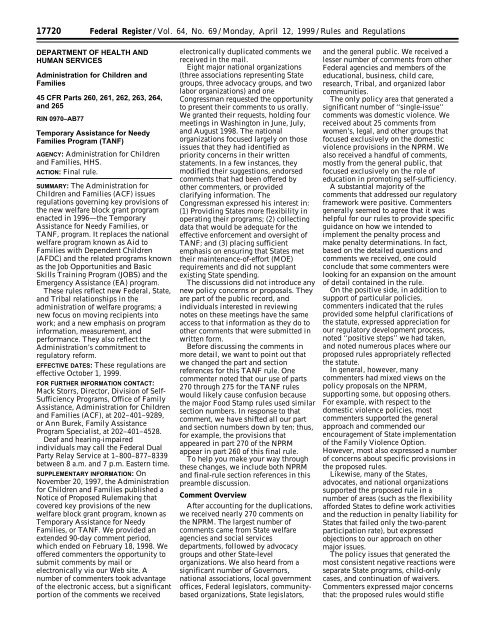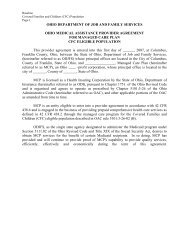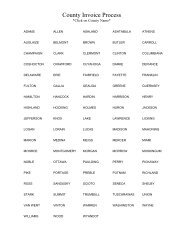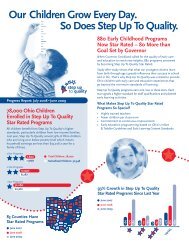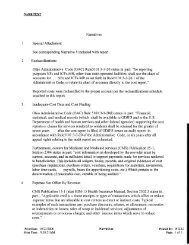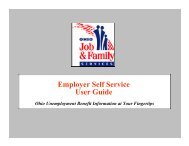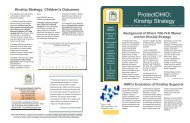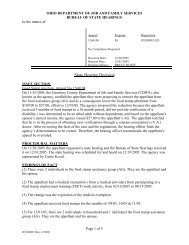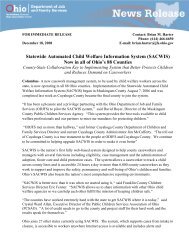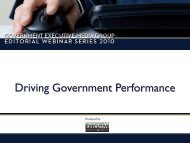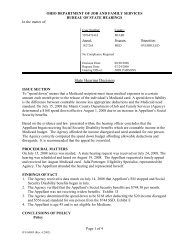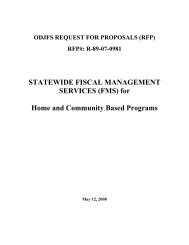Final TANF Rule as published in the Federal Register 4/12/1999
Final TANF Rule as published in the Federal Register 4/12/1999
Final TANF Rule as published in the Federal Register 4/12/1999
Create successful ePaper yourself
Turn your PDF publications into a flip-book with our unique Google optimized e-Paper software.
17720 <strong>Federal</strong> <strong>Register</strong> / Vol. 64, No. 69 / Monday, April <strong>12</strong>, <strong>1999</strong> / <strong>Rule</strong>s and Regulations<br />
DEPARTMENT OF HEALTH AND<br />
HUMAN SERVICES<br />
Adm<strong>in</strong>istration for Children and<br />
Families<br />
45 CFR Parts 260, 261, 262, 263, 264,<br />
and 265<br />
RIN 0970–AB77<br />
Temporary Assistance for Needy<br />
Families Program (<strong>TANF</strong>)<br />
AGENCY: Adm<strong>in</strong>istration for Children<br />
and Families, HHS.<br />
ACTION: <strong>F<strong>in</strong>al</strong> rule.<br />
SUMMARY: The Adm<strong>in</strong>istration for<br />
Children and Families (ACF) issues<br />
regulations govern<strong>in</strong>g key provisions of<br />
<strong>the</strong> new welfare block grant program<br />
enacted <strong>in</strong> 1996—<strong>the</strong> Temporary<br />
Assistance for Needy Families, or<br />
<strong>TANF</strong>, program. It replaces <strong>the</strong> national<br />
welfare program known <strong>as</strong> Aid to<br />
Families with Dependent Children<br />
(AFDC) and <strong>the</strong> related programs known<br />
<strong>as</strong> <strong>the</strong> Job Opportunities and B<strong>as</strong>ic<br />
Skills Tra<strong>in</strong><strong>in</strong>g Program (JOBS) and <strong>the</strong><br />
Emergency Assistance (EA) program.<br />
These rules reflect new <strong>Federal</strong>, State,<br />
and Tribal relationships <strong>in</strong> <strong>the</strong><br />
adm<strong>in</strong>istration of welfare programs; a<br />
new focus on mov<strong>in</strong>g recipients <strong>in</strong>to<br />
work; and a new emph<strong>as</strong>is on program<br />
<strong>in</strong>formation, me<strong>as</strong>urement, and<br />
performance. They also reflect <strong>the</strong><br />
Adm<strong>in</strong>istration’s commitment to<br />
regulatory reform.<br />
EFFECTIVE DATES: These regulations are<br />
effective October 1, <strong>1999</strong>.<br />
FOR FURTHER INFORMATION CONTACT:<br />
Mack Storrs, Director, Division of Self-<br />
Sufficiency Programs, Office of Family<br />
Assistance, Adm<strong>in</strong>istration for Children<br />
and Families (ACF), at 202–401–9289,<br />
or Ann Burek, Family Assistance<br />
Program Specialist, at 202–401–4528.<br />
Deaf and hear<strong>in</strong>g-impaired<br />
<strong>in</strong>dividuals may call <strong>the</strong> <strong>Federal</strong> Dual<br />
Party Relay Service at 1–800–877–8339<br />
between 8 a.m. and 7 p.m. E<strong>as</strong>tern time.<br />
SUPPLEMENTARY INFORMATION: On<br />
November 20, 1997, <strong>the</strong> Adm<strong>in</strong>istration<br />
for Children and Families <strong>published</strong> a<br />
Notice of Proposed <strong>Rule</strong>mak<strong>in</strong>g that<br />
covered key provisions of <strong>the</strong> new<br />
welfare block grant program, known <strong>as</strong><br />
Temporary Assistance for Needy<br />
Families, or <strong>TANF</strong>. We provided an<br />
extended 90-day comment period,<br />
which ended on February 18, 1998. We<br />
offered commenters <strong>the</strong> opportunity to<br />
submit comments by mail or<br />
electronically via our Web site. A<br />
number of commenters took advantage<br />
of <strong>the</strong> electronic access, but a significant<br />
portion of <strong>the</strong> comments we received<br />
electronically duplicated comments we<br />
received <strong>in</strong> <strong>the</strong> mail.<br />
Eight major national organizations<br />
(three <strong>as</strong>sociations represent<strong>in</strong>g State<br />
groups, three advocacy groups, and two<br />
labor organizations) and one<br />
Congressman requested <strong>the</strong> opportunity<br />
to present <strong>the</strong>ir comments to us orally.<br />
We granted <strong>the</strong>ir requests, hold<strong>in</strong>g four<br />
meet<strong>in</strong>gs <strong>in</strong> W<strong>as</strong>h<strong>in</strong>gton <strong>in</strong> June, July,<br />
and August 1998. The national<br />
organizations focused largely on those<br />
issues that <strong>the</strong>y had identified <strong>as</strong><br />
priority concerns <strong>in</strong> <strong>the</strong>ir written<br />
statements. In a few <strong>in</strong>stances, <strong>the</strong>y<br />
modified <strong>the</strong>ir suggestions, endorsed<br />
comments that had been offered by<br />
o<strong>the</strong>r commenters, or provided<br />
clarify<strong>in</strong>g <strong>in</strong>formation. The<br />
Congressman expressed his <strong>in</strong>terest <strong>in</strong>:<br />
(1) Provid<strong>in</strong>g States more flexibility <strong>in</strong><br />
operat<strong>in</strong>g <strong>the</strong>ir programs; (2) collect<strong>in</strong>g<br />
data that would be adequate for <strong>the</strong><br />
effective enforcement and oversight of<br />
<strong>TANF</strong>; and (3) plac<strong>in</strong>g sufficient<br />
emph<strong>as</strong>is on ensur<strong>in</strong>g that States met<br />
<strong>the</strong>ir ma<strong>in</strong>tenance-of-effort (MOE)<br />
requirements and did not supplant<br />
exist<strong>in</strong>g State spend<strong>in</strong>g.<br />
The discussions did not <strong>in</strong>troduce any<br />
new policy concerns or proposals. They<br />
are part of <strong>the</strong> public record, and<br />
<strong>in</strong>dividuals <strong>in</strong>terested <strong>in</strong> review<strong>in</strong>g<br />
notes on <strong>the</strong>se meet<strong>in</strong>gs have <strong>the</strong> same<br />
access to that <strong>in</strong>formation <strong>as</strong> <strong>the</strong>y do to<br />
o<strong>the</strong>r comments that were submitted <strong>in</strong><br />
written form.<br />
Before discuss<strong>in</strong>g <strong>the</strong> comments <strong>in</strong><br />
more detail, we want to po<strong>in</strong>t out that<br />
we changed <strong>the</strong> part and section<br />
references for this <strong>TANF</strong> rule. One<br />
commenter noted that our use of parts<br />
270 through 275 for <strong>the</strong> <strong>TANF</strong> rules<br />
would likely cause confusion because<br />
<strong>the</strong> major Food Stamp rules used similar<br />
section numbers. In response to that<br />
comment, we have shifted all our part<br />
and section numbers down by ten; thus,<br />
for example, <strong>the</strong> provisions that<br />
appeared <strong>in</strong> part 270 of <strong>the</strong> NPRM<br />
appear <strong>in</strong> part 260 of this f<strong>in</strong>al rule.<br />
To help you make your way through<br />
<strong>the</strong>se changes, we <strong>in</strong>clude both NPRM<br />
and f<strong>in</strong>al-rule section references <strong>in</strong> this<br />
preamble discussion.<br />
Comment Overview<br />
After account<strong>in</strong>g for <strong>the</strong> duplications,<br />
we received nearly 270 comments on<br />
<strong>the</strong> NPRM. The largest number of<br />
comments came from State welfare<br />
agencies and social services<br />
departments, followed by advocacy<br />
groups and o<strong>the</strong>r State-level<br />
organizations. We also heard from a<br />
significant number of Governors,<br />
national <strong>as</strong>sociations, local government<br />
offices, <strong>Federal</strong> legislators, communityb<strong>as</strong>ed<br />
organizations, State legislators,<br />
and <strong>the</strong> general public. We received a<br />
lesser number of comments from o<strong>the</strong>r<br />
<strong>Federal</strong> agencies and members of <strong>the</strong><br />
educational, bus<strong>in</strong>ess, child care,<br />
research, Tribal, and organized labor<br />
communities.<br />
The only policy area that generated a<br />
significant number of ‘‘s<strong>in</strong>gle-issue’’<br />
comments w<strong>as</strong> domestic violence. We<br />
received about 25 comments from<br />
women’s, legal, and o<strong>the</strong>r groups that<br />
focused exclusively on <strong>the</strong> domestic<br />
violence provisions <strong>in</strong> <strong>the</strong> NPRM. We<br />
also received a handful of comments,<br />
mostly from <strong>the</strong> general public, that<br />
focused exclusively on <strong>the</strong> role of<br />
education <strong>in</strong> promot<strong>in</strong>g self-sufficiency.<br />
A substantial majority of <strong>the</strong><br />
comments that addressed our regulatory<br />
framework were positive. Commenters<br />
generally seemed to agree that it w<strong>as</strong><br />
helpful for our rules to provide specific<br />
guidance on how we <strong>in</strong>tended to<br />
implement <strong>the</strong> penalty process and<br />
make penalty determ<strong>in</strong>ations. In fact,<br />
b<strong>as</strong>ed on <strong>the</strong> detailed questions and<br />
comments we received, one could<br />
conclude that some commenters were<br />
look<strong>in</strong>g for an expansion on <strong>the</strong> amount<br />
of detail conta<strong>in</strong>ed <strong>in</strong> <strong>the</strong> rule.<br />
On <strong>the</strong> positive side, <strong>in</strong> addition to<br />
support of particular policies,<br />
commenters <strong>in</strong>dicated that <strong>the</strong> rules<br />
provided some helpful clarifications of<br />
<strong>the</strong> statute, expressed appreciation for<br />
our regulatory development process,<br />
noted ‘‘positive steps’’ we had taken,<br />
and noted numerous places where our<br />
proposed rules appropriately reflected<br />
<strong>the</strong> statute.<br />
In general, however, many<br />
commenters had mixed views on <strong>the</strong><br />
policy proposals on <strong>the</strong> NPRM,<br />
support<strong>in</strong>g some, but oppos<strong>in</strong>g o<strong>the</strong>rs.<br />
For example, with respect to <strong>the</strong><br />
domestic violence policies, most<br />
commenters supported <strong>the</strong> general<br />
approach and commended our<br />
encouragement of State implementation<br />
of <strong>the</strong> Family Violence Option.<br />
However, most also expressed a number<br />
of concerns about specific provisions <strong>in</strong><br />
<strong>the</strong> proposed rules.<br />
Likewise, many of <strong>the</strong> States,<br />
advocates, and national organizations<br />
supported <strong>the</strong> proposed rule <strong>in</strong> a<br />
number of are<strong>as</strong> (such <strong>as</strong> <strong>the</strong> flexibility<br />
afforded States to def<strong>in</strong>e work activities<br />
and <strong>the</strong> reduction <strong>in</strong> penalty liability for<br />
States that failed only <strong>the</strong> two-parent<br />
participation rate), but expressed<br />
objections to our approach on o<strong>the</strong>r<br />
major issues.<br />
The policy issues that generated <strong>the</strong><br />
most consistent negative reactions were<br />
separate State programs, child-only<br />
c<strong>as</strong>es, and cont<strong>in</strong>uation of waivers.<br />
Commenters expressed major concerns<br />
that: <strong>the</strong> proposed rules would stifle


